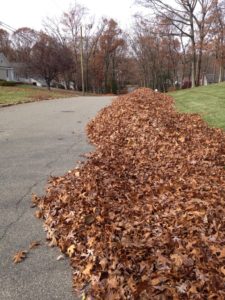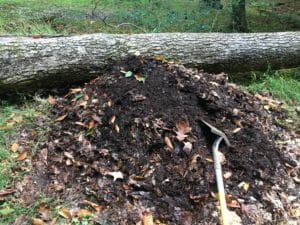Hello Fellow Readers,
Leaf cleanup is underway, which brings me to the subject of leaf manners. It’s not neighborly to put your leaves into other folks’ woods or fields without permission. And, unless your town has a leaf-sucking-up program (curbside vacuuming), putting them in the street is not a polite solution either, as they will blow onto your neighbor’s property.
 Bagging leaves into plastic bags that end up in landfills is a sad fate. But if your town collects paper sacks and brings them to a compost facility, the future of your leaves can be happy.
Bagging leaves into plastic bags that end up in landfills is a sad fate. But if your town collects paper sacks and brings them to a compost facility, the future of your leaves can be happy.
Better yet, why not use your leaves? Leaf mold is composted leaves packed with minerals. When added to your garden, they feed earthworms and beneficial microbes, lighten clay soils, and help retain moisture.
First, shred up your leaves if you can. Shredding leaves prevents them from packing together into layers that won’t allow air or water to penetrate readily. And it reduces the volume dramatically. If you don’t have a leaf shredder, let the leaves pile up on the lawn and then drive over them a few times with the lawnmower.
You can make leaf mold by merely raking the leaves into a big pile and letting them decompose naturally. If shredded, they will decompose faster, but you can still make leaf mold without shredding. I added used coffee grounds to our leaf pile to help further accelerate decomposing. After one to three years, the fungus will break down the leaves into a rich, earthy-smelling black material, much like compost.
There is a technique to make leaf mold in plastic bags punched with holes. Add water to moisten and a scoop of soil, which reduces the time it takes to make leaf mold down to six to twelve months.
You can dig the nutrient-rich leaf mold into your vegetable garden or add it to garden beds. Mixed into container gardens and pots will prevent the soil from drying out so quickly. Or rather than digging it in, you can apply leaf mold as you would mulch. If you don’t like the way leaves look, you can top-dress them with a thin layer of purchased mulch – aged hemlock mulch is my fav. Please avoid using mulch dyed into colors, which can negatively impact plant health.
Helping the well-being of our earth by minding our manners (and recycling leaves) rocks.
Garden dilemmas? AskMaryStone@gmail.com
There’s more to the story in Episode 5 of the Garden Dilemmas Podcast:
Check out a previous column – Leaf Mold – Better than Mulch.




